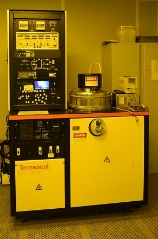EBME / E-beam Metal Evaporation
Electron Beam (E-beam) Metal Evaporation (EBME) is a well-established physical vapor deposition technique for producing high-purity uniform metal coatings on solid or flexible substrates at a rate typically in the range of 0.1nm to 1μm/min. Basically, a high-energy electron beam (also referred to as electron gun) is used to heat the material to be deposited, which evaporates and condenses onto the substrate. EBME is a non-conformal deposition technique and thereby, it is ideal for lift-off processing compared to other techniques (magnetron sputtering, ALD, etc.). Today, ultra-thin multi-layers can be deposited via a multiple crucible system, with the ability to obtain gradient programmed compositions without breaking the vacuum. EBME is used for a wide range of applications ranging from electrical contact engineering and interconnect lines in micro/nanoelectronics to transparent conductive thin films of designed reflective and transmissive properties in optoelectronics including photovoltaics, etc.
Tool
Minilab ET080A
Method
e-Gun evaporation and thermal evaporation
Process Parameters
Metals: Al, Au, Pt, Pd, Ag, Ti, Cr, Ru, Ni, Co.
6 pocket material target revolver for multilayer coatings without braking vacuum, from the e-Gun evaporation
Co-deposition of metals for alloys such as FeNi
e-Gun evaporation source: 5kW, up to 10 kV
Thermal evaporation source: 200A/8V
Substrates: Semiconductors, dielectrics, resists
Substrate Size
From small samples of 1x1 cm2 to 8΄΄ wafers
Applications
Ohmic contacts, Metal electrodes and interconnects of semiconductor devices, etc.
